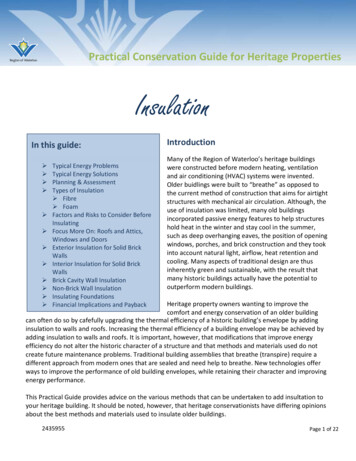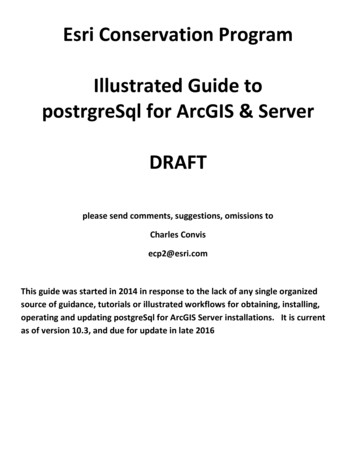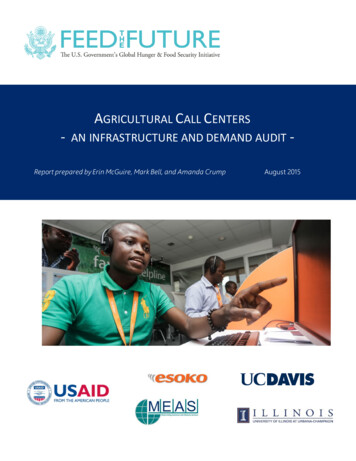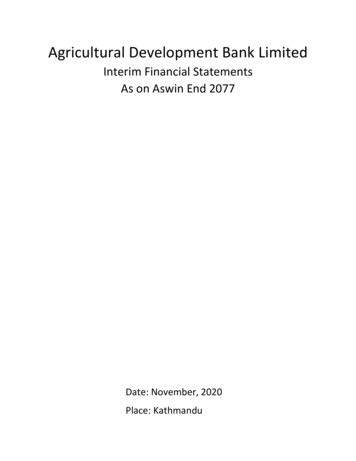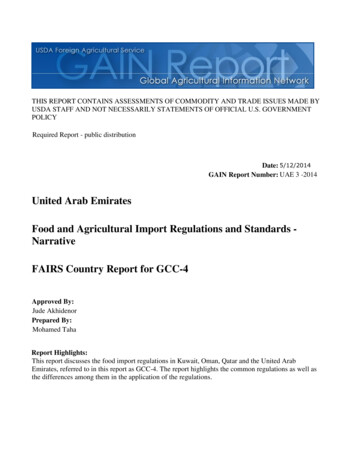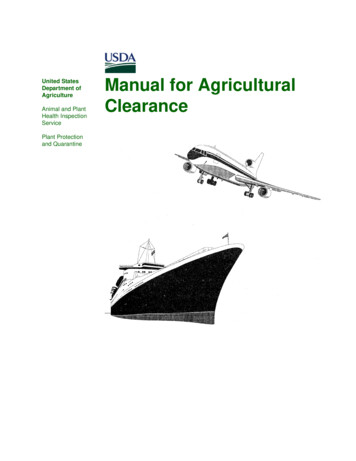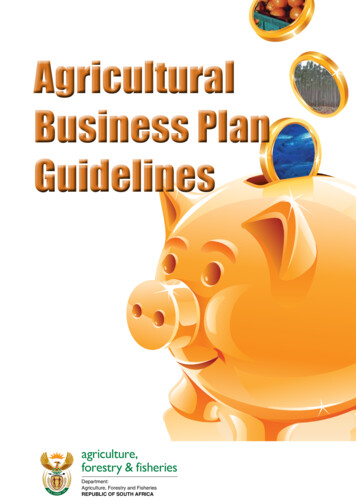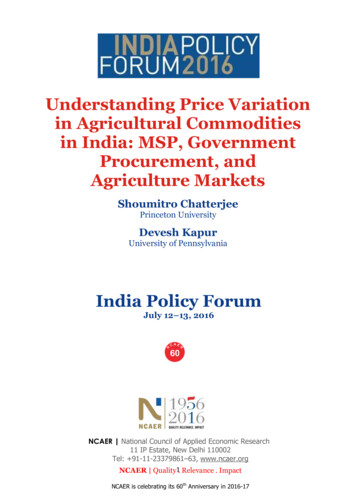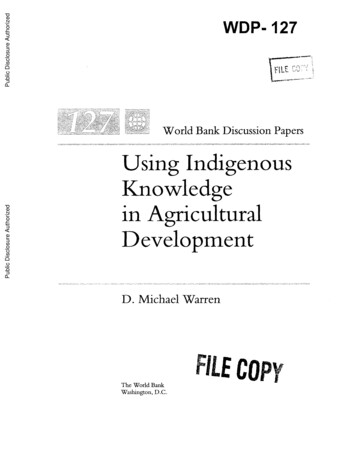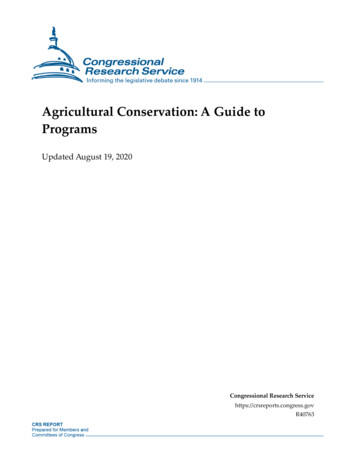
Transcription
Agricultural Conservation: A Guide toProgramsUpdated August 19, 2020Congressional Research Servicehttps://crsreports.congress.govR40763
SUMMARYAgricultural Conservation: A Guide toProgramsThe Natural Resources Conservation Service (NRCS) and the Farm Service Agency(FSA) in the U.S. Department of Agriculture (USDA) currently administer over 20programs and subprograms that are directly or indirectly available to assist producersand landowners who wish to practice conservation on agricultural lands. The number ofthese programs and the differences among them have created some confusion about thepurpose, participation, and policies of the programs. While some effort has been made toremove duplication, a large number of programs remain, including the following:R40763August 19, 2020Megan StubbsSpecialist in AgriculturalConservation and NaturalResources Policy Agricultural Conservation Easement Program (ACEP) Agricultural Management Assistance (AMA) Conservation Operations (CO); Conservation Technical Assistance (CTA) Conservation Reserve Program (CRP) CRP—Conservation Reserve Enhancement Program (CREP) CRP—CLEAR30 CRP—Farmable Wetland Program CRP—Grasslands CRP—Soil Health and Income Protection Program (SHIPP) Conservation Stewardship Program (CSP) CSP—Grassland Conservation Initiative (GCI) Emergency Conservation Program (ECP) Emergency Forest Restoration Program (EFRP) Emergency Watershed Protection (EWP) Environmental Quality Incentives Program (EQIP) EQIP—Conservation Innovation Grants (CIG) EQIP, CIG—On-Farm Conservation Innovation Trials Feral Swine Eradication and Control Pilot Program Grassroots Source Water Protection Program Healthy Forests Reserve Program (HFRP) Regional Conservation Partnership Program (RCPP) Voluntary Public Access and Habitat Incentive Program Water Bank Program Watershed and Flood Prevention Operations Watershed Rehabilitation ProgramThese programs endeavor to protect soil, water, wildlife, and other natural resources on privately ownedagricultural lands to limit environmental impacts of production activities both on and off the farm whilemaintaining or improving production of food and fiber. Some of these programs center on improving or restoringresources that have been degraded, while others seek to create conditions with the objective of limitingdegradation in the future. In general, agricultural conservation programs can be grouped into the followingcategories based on similarities: working lands, land retirement, easement, partnership and grants, compliance,technical assistance, emergency assistance, watershed, and other programs and provisions.Congressional Research Service
Agricultural Conservation: A Guide to ProgramsContentsIntroduction . 1Overview . 22018 Farm Bill. 3Conservation Programs . 4Agricultural Conservation Easement Program (ACEP) . 5Agricultural Management Assistance (AMA). 6Conservation Operations (CO)—Conservation Technical Assistance (CTA) . 7Conservation Reserve Program (CRP) . 8CRP—Conservation Reserve Enhancement Program (CREP) . 9CRP—CLEAR30 . 10CRP—Farmable Wetland Program . 11CRP—Grasslands. 12CRP—Soil Health and Income Protection Program (SHIPP) . 13Conservation Stewardship Program (CSP) . 14CSP—Grassland Conservation Initiative (GCI) . 15Emergency Conservation Program (ECP) . 16Emergency Forest Restoration Program (EFRP) . 17Emergency Watershed Protection (EWP). 18Environmental Quality Incentives Program (EQIP) . 19EQIP—Conservation Innovation Grants (CIG) . 20EQIP, CIG—On-Farm Conservation Innovation Trials . 21Feral Swine Eradication and Control Pilot Program . 22Grassroots Source Water Protection Program . 23Healthy Forests Reserve Program (HFRP) . 24Regional Conservation Partnership Program (RCPP) . 25Voluntary Public Access and Habitat Incentive Program . 26Water Bank Program . 27Watershed and Flood Prevention Operations . 28Watershed Rehabilitation Program. 29FiguresFigure 1. USDA Agricultural Conservation Programs by Type . 3ContactsAuthor Information. 30Congressional Research Service
Agricultural Conservation: A Guide to ProgramsIntroductionThe U.S. Department of Agriculture (USDA) administers a number of agricultural conservationprograms that assist private landowners with natural resource concerns. The number and fundinglevels for agricultural conservation programs have steadily increased over the past 60 years. Earlyconservation efforts undertaken by Congress focused on reducing high levels of soil erosion andproviding water to agriculture in quantities and quality that enhanced farm production. By theearly 1980s, however, concern was growing that these programs were not adequately dealing withenvironmental problems—especially those occurring off the farm—resulting from agriculturalactivities. In 1985, conservation policy took a new direction when Congress passed the FoodSecurity Act of 1985 (1985 farm bill, P.L. 99-198), which established the first conservationprograms designed to deal with environmental issues resulting from agricultural activities.Provisions enacted in subsequent farm bills in 1990, 1996, 2002, 2008, 2014, and 20181 reflect arapid evolution of the conservation agenda, including the growing influence of environmentalistsand other nonagricultural interests in the formulation of conservation policy, and a recognitionthat agriculture was not treated like other business sectors in many environmental laws.2 Congressalso began funding many of these new programs through mandatory spending for the first time,using the borrowing authority of USDA’s Commodity Credit Corporation (CCC)3 as the fundingmechanism instead of annual appropriations. In addition to the original soil erosion and waterquality and quantity issues, the conservation agenda has continued to expand to address othernatural resource concerns, such as wildlife habitat, air quality, wetlands restoration andprotection, energy efficiency, and sustainable agriculture.Lead agricultural conservation agencies within USDA are the Natural Resources ConservationService (NRCS), which provides technical assistance and administers most conservationprograms, and the Farm Service Agency (FSA), which administers the Conservation ReserveProgram (CRP). These agencies are supported by others in USDA that supply research andeducational assistance, including the Agricultural Research Service (ARS), the EconomicResearch Service (ERS), the National Institute of Food and Agriculture (NIFA), and the ForestService (FS).4 In addition, agricultural conservation programs involve a large array of partners,including other federal agencies, state and local governments, and private organizations, amongothers, who provide funds, expertise, and other forms of assistance to further agriculturalconservation efforts.1Conservation and Trade Act of 1990 (P.L. 101-624), Federal Agricultural Improvement and Reform Act of 1996 (P.L.104-127), Farm Security and Rural Investment Act of 2002 (P.L. 107-171), Food, Conservation, and Energy Act of2008 (P.L. 110-246), Agricultural Act of 2014 (P.L. 113-79), and Agriculture Improvement Act of 2018 (P.L. 115334).2 For additional discussion on conservation in the farm bill, see CRS Report R45698, Agricultural Conservation in the2018 Farm Bill.3 The CCC is the funding mechanism for the mandatory payments that are administered by various agencies of USDA,including all of the farm commodity price and income support programs. For more information on the CCC, see CRSReport R44606, The Commodity Credit Corporation: In Brief.4 For more information on ARS projects, see http://www.ars.usda.gov/Research/Research.htm; ERS projects, s-environment/conservation-programs.aspx; NIFA programs, seehttp://www.nifa.usda.gov; and FS projects, see http://www.fs.fed.us/projects/.Congressional Research Service1
Agricultural Conservation: A Guide to ProgramsOverviewUSDA provides technical and financial assistance to attract interest and encourage participation inconservation programs. Participation in all USDA conservation programs is voluntary. Theseprograms endeavor to protect soil, water, wildlife, and other natural resources on privately ownedagricultural lands to limit environmental impacts of production activities both on and off thefarm, while maintaining or improving production of food and fiber. Some of these programscenter on improving or restoring resources that have been degraded, while others seek to createconditions with the objective of limiting degradation in the future.Although programs in this report are listed alphabetically, agricultural conservation programs canbe grouped into the following categories based on similarities: working lands, land retirement,easement, partnership and grants, compliance,5 technical assistance, emergency assistance,6watershed, and other programs and provisions (Figure 1).The majority of conservation programs are funded through CCC as mandatory spending.Congress authorizes mandatory programs at specified funding levels (or acreage enrollmentlevels for CRP) for multiple years, typically through omnibus legislation such as the farm bill.Mandatory programs are funded at these levels unless Congress limits funding to a lower amountthrough the appropriations or legislative process or puts a ceiling on acreage that can be enrolled.7Discretionary programs are funded each year through the annual appropriations process.8Sequestration continues to have an effect on conservation programs. Sequestration is a process ofautomatic, largely across-the-board reductions that permanently cancel mandatory and/ordiscretionary budget authority to enforce statutory budget goals.9 Discretionary accounts haveavoided sequestration in recent years through adjustments to spending limits, althoughsequestration continues on mandatory accounts. Most mandatory conservation programs weresubject to sequestration in FY2014 through FY2020.10 Even with sequestration andappropriations act reductions, total annual mandatory budget authority for conservation programshas grown from a total of 3.9 billion in FY2008 to over 6.7 billion in FY2020.115Compliance refers to a series of farm bill provisions that require a minimum level of conservation on environmentallysensitive land in exchange for access to other USDA program benefits. Compliance provisions are not discussed in thisreport. Additional analysis may be found in CRS Report R42459, Conservation Compliance and U.S. Farm Policy.6 Additional information on emergency land rehabilitation programs may be found in CRS Report R42854, EmergencyAssistance for Agricultural Land Rehabilitation.7 Reduction to mandatory funding authority for agricultural conservation programs occurred annually throughappropriations acts from FY2003 through FY2017. FY2018 was the first appropriations act since FY2002 that did notreduce mandatory conservation program funding. For additional discussion on these reductions, see CRS In FocusIF10041, Reductions to Mandatory Agricultural Conservation Programs in Appropriations Law.8 For additional information on the FY2020 conservation appropriation, see CRS Report R46011, FY2020Appropriations for Agricultural Conservation.9 For additional information on sequestration and the budget process, see CRS Report R42972, Sequestration as aBudget Enforcement Process: Frequently Asked Questions.10 The Conservation Reserve Program is statutorily exempt from sequestration (2 U.S.C. 905 (g)(1)(A)). Sequestrationreductions announced for FY2019 were reflected in the Congressional Budget Office (CBO) baseline that was used towrite the 2018 farm bill. For more information, see CRS Report R45425, Budget Issues That Shaped the 2018 FarmBill. Sequestration estimates may be found in the Office of Management and Budget’s (OMB’s) Reports to theCongress on the Joint Committee Reductions, at ration-reportsorders/.11 CRS using CBO baseline data, FY2008-FY2020.Congressional Research Service2
Agricultural Conservation: A Guide to ProgramsFigure 1. USDA Agricultural Conservation Programs by TypeSource: CRS.2018 Farm BillThe conservation title of the Agriculture Improvement Act of 2018 (2018 farm bill; P.L. 115-334,Title II) reauthorized and amended many of the largest conservation programs and created anumber of new pilot programs, carve-outs, and initiatives. The House- and Senate-passed farmbills (H.R. 2) each included a number of amendments to existing conservation programs, many ofwhich did not overlap. This generally resulted in the inclusion of a mix of amendments from eachCongressional Research Service3
Agricultural Conservation: A Guide to Programschamber in the enacted bill and an overall expansion in the number of conservation programs andinitiatives. For additional information on conservation programs in the 2018 farm bill, see CRSReport R45698, Agricultural Conservation in the 2018 Farm Bill.Conservation ProgramsThe tabular presentation that follows provides basic information covering each of the USDAagricultural conservation programs, including administering agency or agencies within USDA;brief program description;summary of major amendments to the program in the Agriculture ImprovementAct of 2018 (P.L. 115-334), commonly referred to as the 2018 farm bill; national scope and availability, including participation levels and acres enrolled;states with the highest level of funds obligated or acres enrolled;volume of application backlog or public interest in each program;authorized funding levels, whether mandatory spending or discretionaryappropriations, and any funding restrictions;FY2020 funding level in the Further Consolidated Appropriations Act, 2020 (P.L.116-94, Division B), or, if applicable, the authorized level in the AgricultureImprovement Act of 2018 (sequestration, transfers, and carryover are includedand noted where known);FY2021 funding level requested by the Administration (sequestration andcarryover is not included unless noted);statutory authority, recent amendments, and U.S. Code reference;expiration date of program authority unless permanently authorized; andprogram’s website link. Information for the following tables is drawn from agency budget presentations, explanatorynotes, and websites; written responses to questions published each year in hearing records of theAgriculture Appropriations Subcommittees of the House and Senate Appropriations Committees;and spending estimates from the Congressional Budget Office. Some figures may not total due torounding. Further information about these programs may be found on the NRCS website athttp://www.nrcs.usda.gov and on the “conservation programs” page of the FSA website athttp://www.fsa.usda.gov.Congressional Research Service4
Agricultural Conservation: A Guide to ProgramsAgricultural Conservation Easement Program nACEP provides financial and technical assistance through two types of easements:agricultural land easements that limit nonagricultural uses on productive farm or grasslands, and wetland reserve easements that protect and restore wetlands.Agricultural Land Easements (ALE)—Enrollment is through eligible entities that enter intocooperative agreements to obligate ACEP funds. The entities acquire easements and hold,monitor, manage, and enforce the easements. The federal share of easement acquisitioncannot exceed 50% of the appraised fair market value or 75% if it is determined to be agrassland of special environmental significance.Wetland Reserve Easement (WRE)—Enrollment options (federal share) include permanenteasements (100% easement value and 75%-100% restoration cost), 30-year easements(50%-75% easement value and 50%-75% restoration cost), term easements or themaximum duration under state law (50%-75% easement value and 50%-75% restorationcost), and 30-year contracts only available to Indian tribes (50%-75% easement value and50%-75% restoration cost). NRCS pays all costs associated with recording the easement.Major 2018 farmbill amendmentsACEP was reauthorized and amended with most changes affecting ALE. Amendments toALE include providing additional flexibilities to ACEP-eligible entities; creating a new “buyprotect-sell” transaction; reducing the eligible entity’s nonfederal contribution; changingUSDA’s administrative role; and clarifying requirements for subordination, exchange,modification, and termination of easements. Amendments to WRE center on changes tocompatible use and vegetative cover requirements. Funding for ACEP was also increased.National scopeAvailable nationwide. Easements are considered enrolled when the landowner and NRCSenter into the agreement authorizing NRCS to proceed with the purchase of theeasement. The easement is closed when the purchase is complete and formally recorded.In FY2019, 245 million in ACEP funding was used to enroll an estimated total of 159,031acres of farmland, grassland, and wetlands through 459 new ACEP enrollments, as well asclosing 400 easements on 163,157 acres. This includes ALE easements––117 on 41,519acres; ALE grassland easements––16 on 46,907 acres; WRE permanent easements––255on 38,128 acres; WRE 30-year easements––5 on 386 acres; and no WRE 30-yearcontracts with Tribes.Leading statesThe highest levels of funding obligated in FY2019 were in FL ( 29.7 million), LA ( 23.9million), and MS ( 23.4 million).Backlog/InterestAgricultural Land Easements (ALE)—In
Aug 19, 2020 · Watershed Rehabilitation Program These programs endeavor to protect soil, water, wildlife, and other natural resources on privately owned agricultural lands to limit environmental impacts of production activities both on and off the farm while
